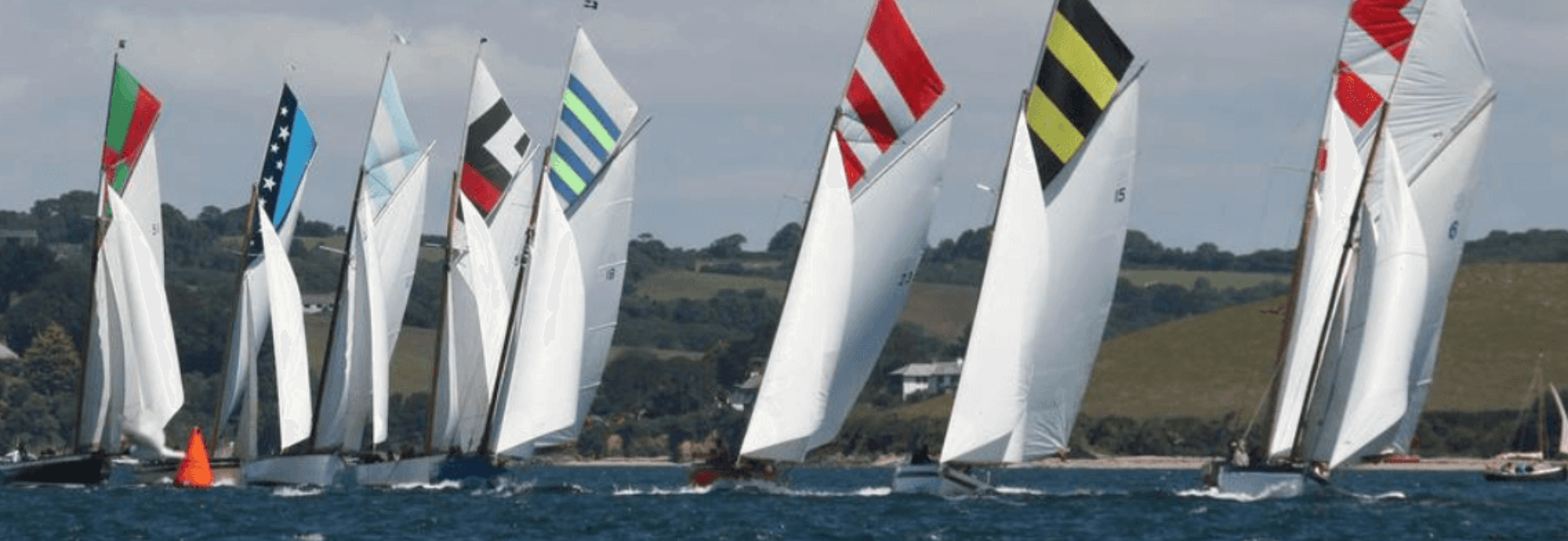

By Linda Batchelor
When this provision was first passed as a byelaw by the Truro Corporation in 1868, it was an early example of a conservation measure providing protection for the oyster beds of the Fal estuary. It also provided the impetus for the distinctive design and building of the river dredging oyster boats of the Truro River now known as Falmouth Working Boats.
These boats constitute a fleet working in the Fal propelled by only sail or oars where oysters are gathered by hand dredging – the last oyster fishery in Europe using these traditional non mechanical means. Alongside the fishing fleet there is also the smaller racing fleet, which with dramatically increased sail areas and coloured topsails, take part during the summer months in local regattas and in Falmouth Week in August.
Originally boats were of wooden construction and some of the older wooden boats still survive and have been restored. Newer boats use modern materials such as fibreglass but continue to use the basic hull form and traditional rig. Many boats are still used for dredging whilst others have been acquired solely for racing. Hand dredging by sail or oars has preserved the oyster banks, the methods of working and the design of the vessels.
The oyster dredging season lasts from the beginning of October until the end of March leaving the summer for other work, such as inshore fishing, and traditionally for regattas and for racing. Racing their dredging boats in the village and town regattas around the Fal Estuary became a sport for skippers, their crews and families and became embedded as an essential part of the lifestyle of the working boat community. Interest has grown over this racing aspect of the working boat and the current fleet of boats that regularly race have evolved from this heritage.
A number of the wooden boats from the nineteenth century such as Winnie, Victory and Evelyn survive and form part of today’s racing fleet. Evelyn built in 1898 celebrates her 125th anniversary in August this year.
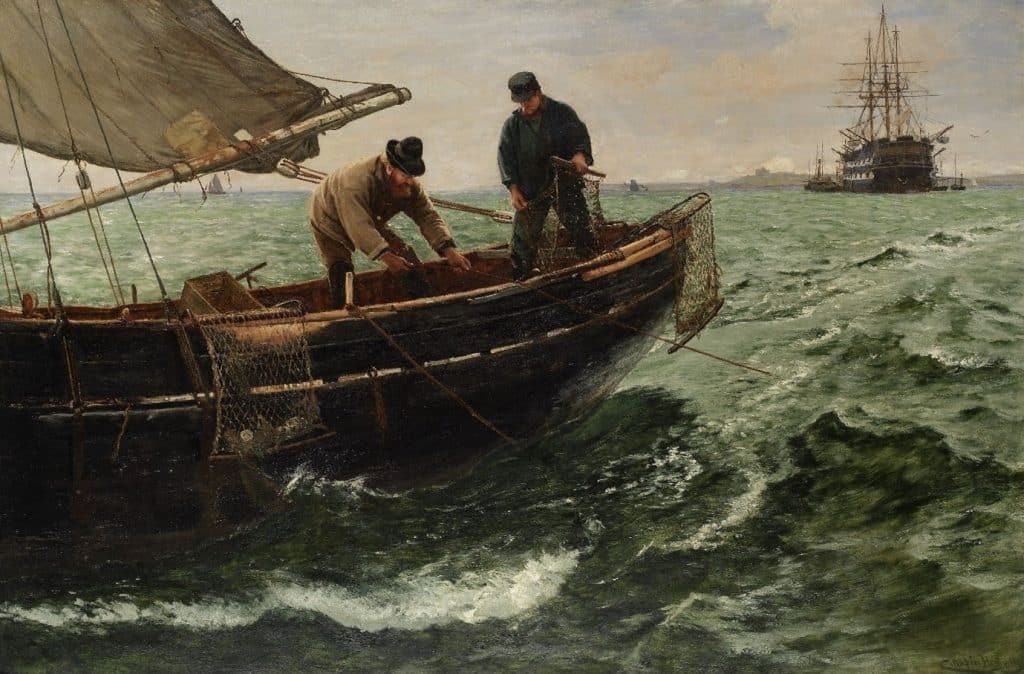
‘Falmouth Natives’ by Charles Napier Hemy RA RWS (1841-1917). Falmouth Art Gallery.
Oil painting dated 1886 depicting fishermen oyster dredging from a working sail boat off Falmouth.
Oysters have been fished in these waters, which are a natural and wild fishery, for centuries. It is thought that the Phoenicians and Romans collected oysters from Cornwall and there are well documented references to the Fal oyster fishery in the seventeenth and eighteenth centuries.
During the nineteenth century the Fal fisheries were boosted by problems of supply in other fisheries but by the 1860s the Fal saw a reduction in production of oysters because of disease, pollution and overfishing. The industry was saved by the regulation for hand dredging by ‘sail or oar’ and the requirement of a licence for each dredge, a system which still exists today.
The Fal oyster, the Ostrea edulis, is not cultured or bred but grows naturally on the seabed. The oysters have a scaly rough shell which is brown, yellow or cream with concentric bluish bands on the outside. Each half of the shell has a different shape, the left is deeply concave and the right is flatter and rougher. Inside the shell is smooth and pearly with cream coloured flesh.
The fishery is within the Truro Port Fishery, an area of 2721 acres, which includes all parts of the Truro and Falmouth Harbours and the bed of the Truro, Fal and Tresillian Rivers.
Two methods of dredging, with no mechanical means, are used by boats propelled by oars or working under sail. Although some boats may be fitted with an engine these can only be used to reach the dredging areas. Dredges are shaped bags made from metal rings towed astern by the boat and a dredging run is known as a drift. A sailing boat may make up to eight or nine drifts during dredging time and a rowing boat thirty or forty drifts.
Dredging is only permitted during the ‘open season’ of October to March from 9am to 3pm on weekdays and 9am to 1pm on Saturdays with no fishing on Sundays.
Rowing boats built specifically for the trade, known as haul – tow punts, are usually worked by one person operating with a single oar whilst dredging. The dredger rows standing in the centre of the boat and operates a wink, two drums which separately control the anchor and dredge which is lowered over the stern. At the end of a drift the dredge is hauled in by hand and the contents cleaned and sorted.
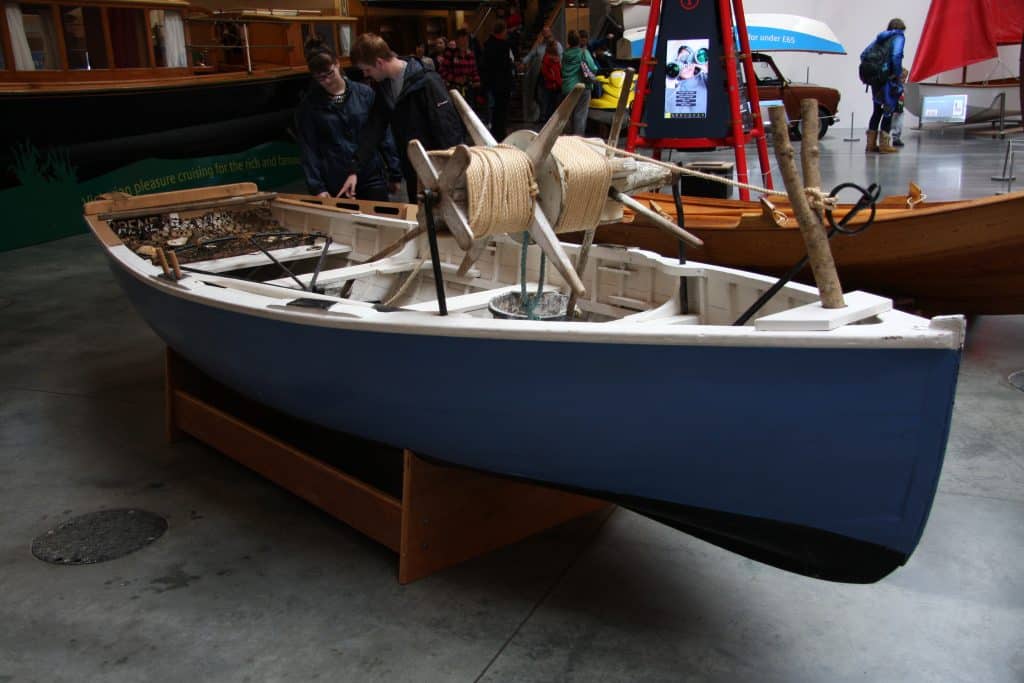
Haul – tow punt Irene, part of the Boat Collection at the National Maritime Museum Cornwall. ©NMMC
Smaller sailing boats are worked single handed and tow one or two dredges whilst larger boats are usually worked by two persons and carry more dredges. The dredges are thrown over the side and towed over the quarter rather than the stern.
To reduce the speed of the boat through the water the sails may be ‘scandalised’ or reduced in area, allowing the craft to be unattended and leaving the dredgers free to work.
After the boat has travelled a short distance the dredge is hand hauled aboard and the contents are cleaned and sorted on a wooden tray.
The minimum size of oyster which is harvested is determined by fishery byelaws. Only oysters which hang on a ring of 2 5/8ths inches in diameter can be harvested and oysters which pass through the ring must be put back into the fishery over the side of the boat.
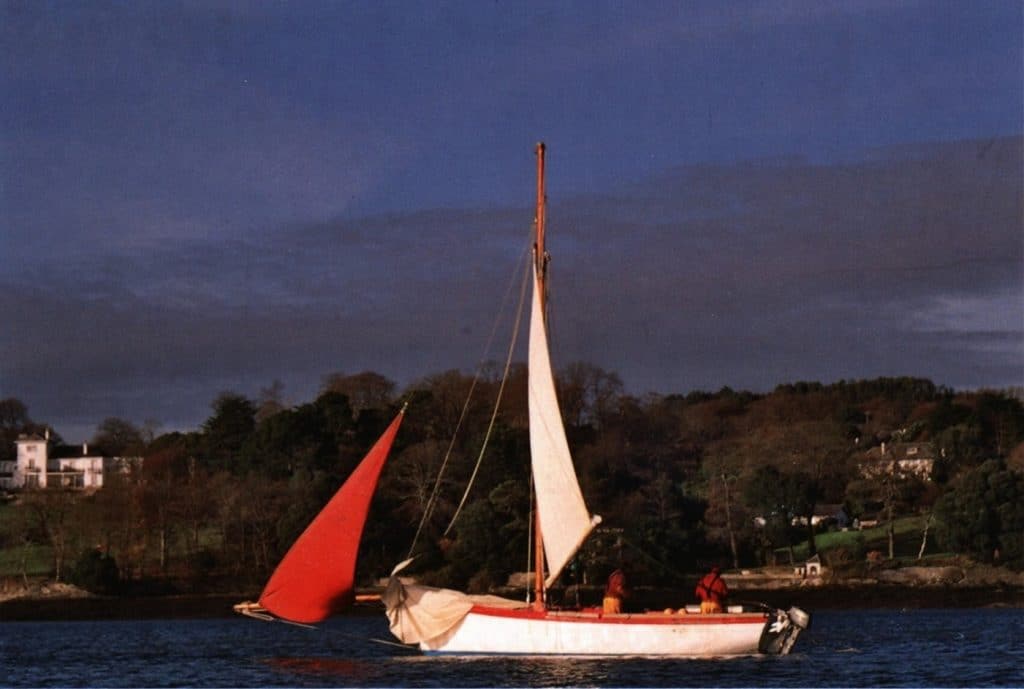
Dolly, named Five Sisters when built in 1914, dredging in the River Fal. David Wilson Collection ©NMMC
The sailing boats may vary in size, materials, origin and age but follow a nineteenth century design of wooden gaff rigged cutters with a distinctive bowsprit of 12 to 14 feet. Most are between 23 and 28 feet overall excluding the bowsprit, with a long keel and graceful lines.
These boats are designed for practicality in working the oyster beds, back and forth in the estuary operated under sail by only one or two persons but they can also be exciting and fast racing boats.
They have a large mainsail, a stay sail and a jib sail. For the working boats involved in dredging the sail area needs to be limited and is usually around 300 square feet and less than 500 square feet but for the racing boats the sail area is dramatically increased. On these boats there may be up to 1,000 square feet of sail and brightly coloured topsails.
Although originally the boats were wooden now many are constructed using modern building materials.
The Falmouth Working Boat Association (FWBA) was formed in the late winter/early spring of 1978/79 when the owners of the working boats felt that an association should be formed which would be the governing body whose main aim was ‘to preserve and encourage the unique traditions of the gaff-rigged oyster dredgers’.
A group of five of the skippers were nominated to draw up a set of rules to determine what constituted a ‘working boat’ and which would maintain the hull shape and rig of the traditional oyster working boat.
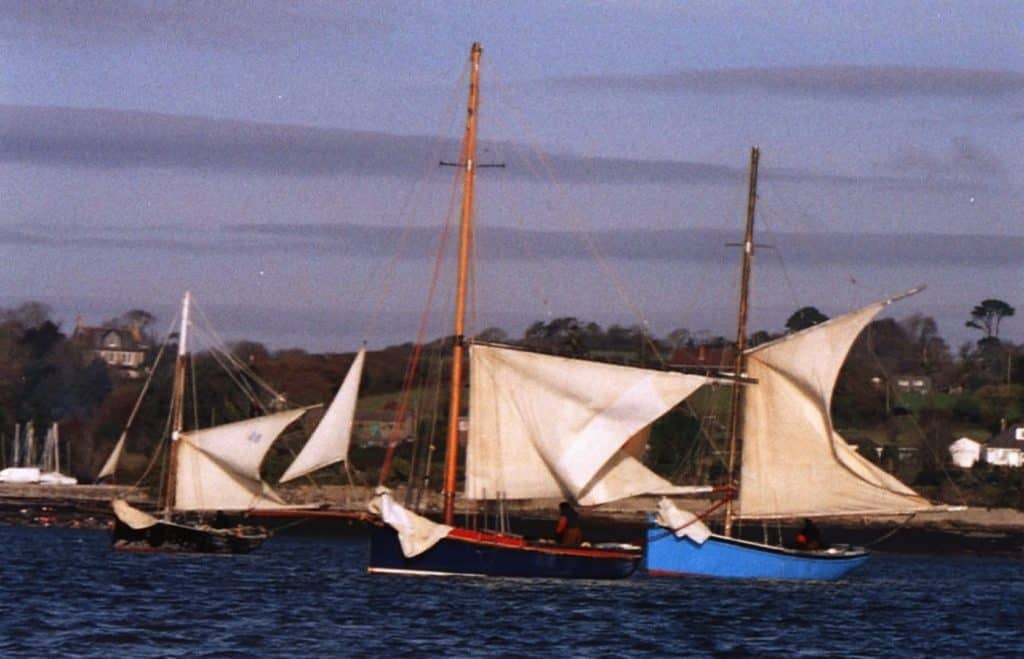
Part of the oyster fleet, Shadow, Boy Willie and Six Brothers dredging off Loe Beach with ‘scandalised’ main sails. David Wilson Collection ©NMMC
Over the years the boats have been built in various boatyards in Cornwall but particularly those around the Fal.
Many of the older boats were built by craftsmen in Brabyn’s Yard in Calenick Creek. William Ferris worked at Pill Creek and Frank Hitchens and his son Tom at Penpol Creek and Restronguet Creek. Frank was the builder of Evelyn and a number of other members of the racing fleet such as Victory.
Over the years boatbuilders have also repaired, refurbished and built working boats. In the mid twentieth century designers and boat builders such as Percy Dalton and Terry Heard at Mylor Bridge produced working boats which, whilst using modern materials, remained true to the traditional form.
This fleet of boats which race regularly, is smaller than the working boat fleet. They are of mixed origin and age and six, such as Evelyn and Winnie, are older wooden boats.
The Falmouth Working Boat Association sets the rules for racing and organises the summer racing programme which has the spectacular Falmouth Week in August. The FWBA is managed by an elected General Committee with an AGM held in November each year. Skippers and crews meetings are held at the beginning and end of each season.
The Racing Fleet has two classes of boats. The ‘B’ class for larger boats up to 29 feet hull length, with a bowsprit between 12 to 14 feet and up to 1000 square feet of sail. The ‘C’ class is for smaller boats up to 25 feet length, with bowsprits of 12 feet or less and 650 square feet of sail. At present there are eighteen ‘B’ class and nine ‘C’ class boats registered with the FWBA.
Racing boats have coloured topsails which are distinctive and identify each boat individually.
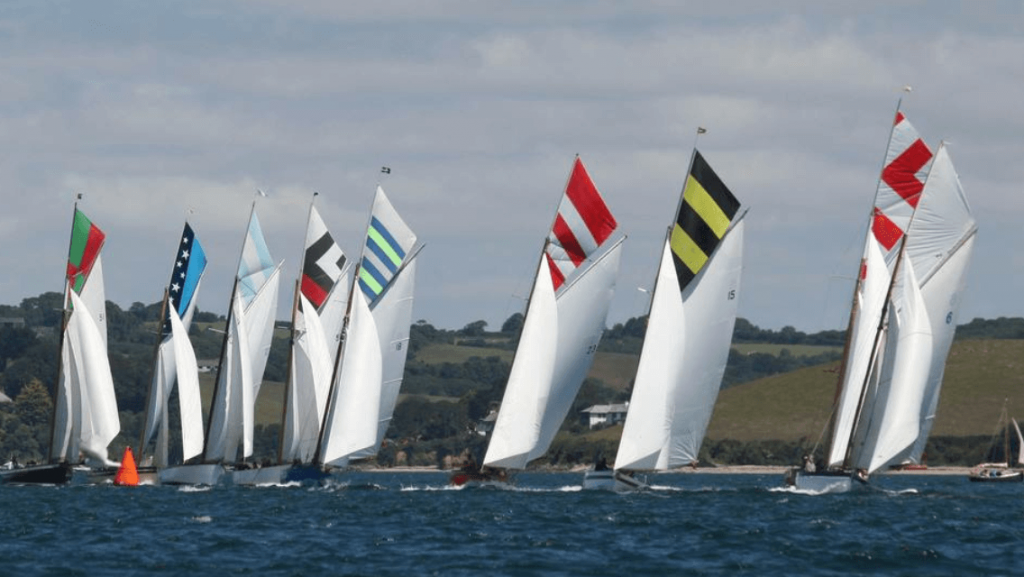
Racing boats with their coloured topsails. © Evelyn Website
The FWBA also has a permanent elected Handicap Committee which sets a racing handicap system for the whole fleet as a way to even up the competition.
The Racing Fleet are the more public face of the FWBA and they are keen to encourage interest from a younger generation to ensure the future of crews for the racing aspect of the Working Boat.
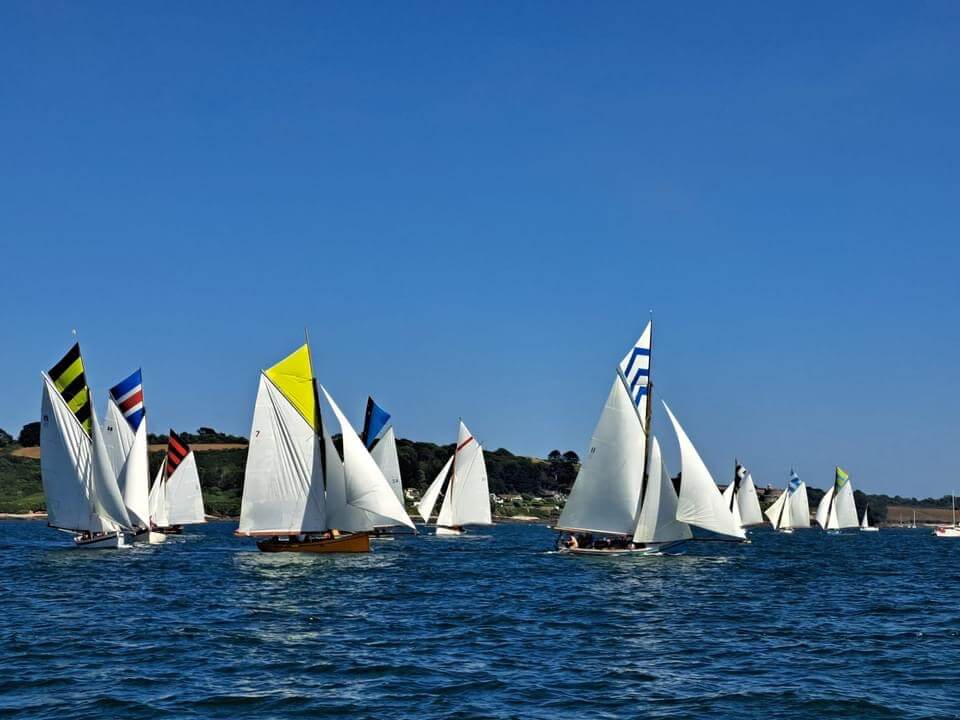
The Racing Fleet in Carrick Roads. © Evelyn Website
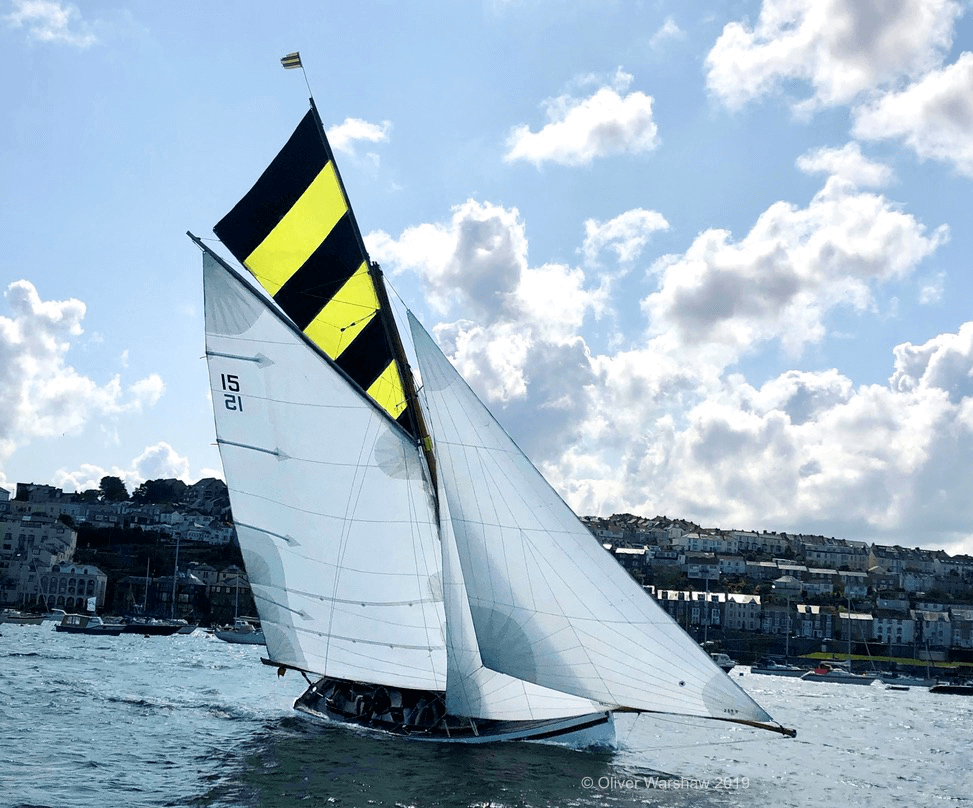
Evelyn with racing topsail in Falmouth Harbour 2019. © Oliver Warshaw
Evelyn was built in 1898 on the beach at Yard Point on the Restronguet Creek by Frank Hitchens, a master shipwright, with the assistance of his son Tom. Another son, James Hitchens a fisherman, had a daughter called Evelyn and it was after her that the boat was named.
Constructed of pitch-pine planking on oak frames she was built with the specific aim of being the working boat to beat all others.
Registered for nets, lines and crabbing by Thos. & James Hitchens (Feock) she was sold in 1905 to the Billings family of Flushing who, as well as using her for trawling and crabbing, commissioned Jacketts of Falmouth to put on an iron ballast keel to further improve her sailing performance.
In 1935 Evelyn was sold and for the next 30 years she had various owners along the coast who used her for fishing and recreational purposes with additions such as the fitting of a marine engine, a coachroof with cooking stove, a single bunk and heads.
In 1965 she returned to Flushing from Penzance, and under the ownership of Kenny Corke she was ‘reconverted’ with the engine and coachroof removed and the foredeck rebuilt so that she could start dredging for oysters in the Carrick Roads. A few years later, Kenny decided to start racing her having been repeatedly told that she was the fastest working boat in the fleet, and in the late 60s she won her very first race at the Mylor Village regatta. Over the next 20 years or so Evelyn spent the winters dredging for oysters and the summers racing in the Falmouth Working Boat fleet, winning in one season over 21 trophies!
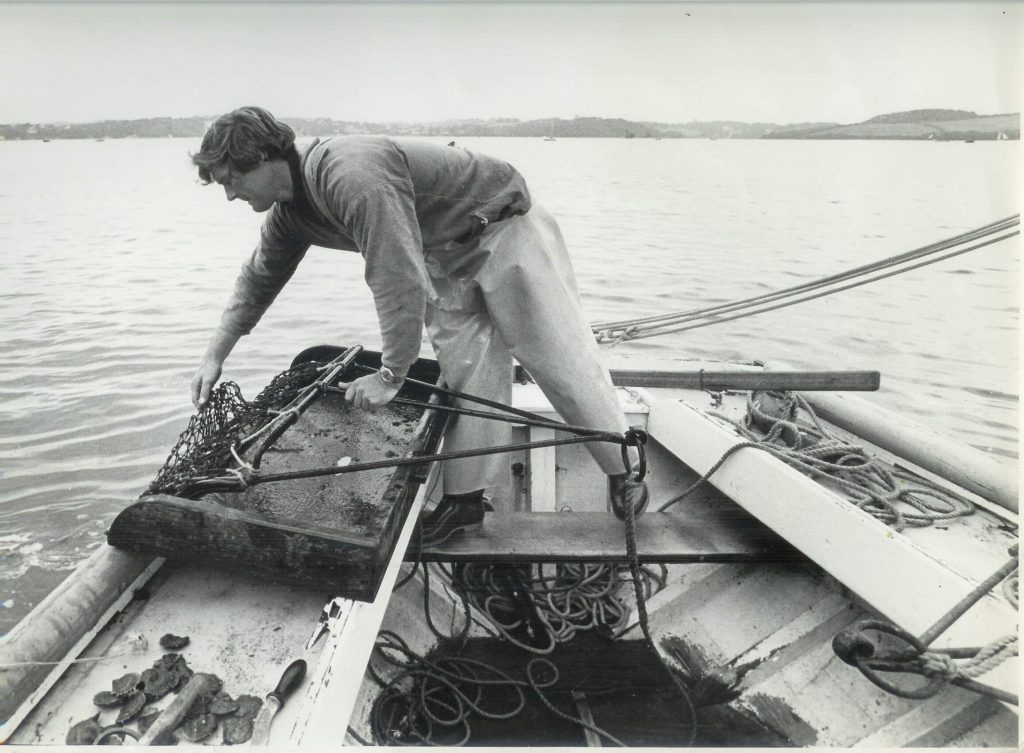
Kenny Corke oyster dredging in Evelyn. © Evelyn Website
In the late 1980s she was sold to Bernie Trenoweth who wanted her solely for racing. In his yard at Penryn, to further improve Evelyn’s competitiveness, he added a two-ton iron keel, a new teak foredeck, new spars, several frames and fastenings. All of which paid off handsomely with Evelyn having many very successful racing seasons. However, Evelyn’s triumph resulted in the introduction, in the early 1990s, of a racing handicap system.
At around this time Bernie decided to sell Evelyn and coincidentally at around this time the Roseland Working Boat Syndicate was being formed by three good friends, Andy Tyler, David Mathewson and Glen Litherland. They sailed their own boats from St Mawes Sailing Club and their passion for both sailing and wooden boats resulted in the formation of the Syndicate. As soon as Evelyn’s availability became known to the Syndicate plans to purchase a GRP boat were immediately dropped and in 1994 she was sold to the Roseland Working Boat Syndicate.
In the long standing tradition of shared boat ownership, there are thirty two Syndicate shares, but with some shares having been divided into half shares, there are 40 Syndicate members today. One of those members is Malcolm Hitchens, the Great-Great-Grandson of Frank Hitchens, the master shipwright who built Evelyn in 1898. Each member pays an annual subscription to pay for maintenance to keep Evelyn in good racing condition throughout the season. The Syndicate is managed by an elected committee of members who take responsibility for appointing skippers and ensuring that there are sufficient funds to provide for Evelyn’s upkeep. There is now a new chapter in Evelyn’s long life.
The small fleet of Working Boats have survived to continue oyster dredging and have preserved the sailing traditions of the Fal oyster fishery. The way of life, the methods of working, and the boats are still part of the local scene and a unique survival of a centuries old industry in a modern context.
The Racing Fleet demonstrate another aspect of the Working Boat and with their speed, grace and excitement provide a colourful and spectacular sight during the racing season.
Both old and new boats still work in oyster fishing or compete in the racing aspect of these traditional sailing vessels. At various times of the year Working Boats can be seen in the Fal Estuary either providing views of the practicality of oyster dredging or the excitement of racing. It is the combination of both tradition and innovation which will continue to ensure future sustainability and the preservation of the Working Boats of the Fal.
This Blog has been written using archive material and images from the NMMC Bartlett Library and, with their kind permission, material and images from the Evelyn website.
For further information about Working Boats see www.fwba.co.uk and www.evelynworkingboat.org
The Bartlett Blog is written and produced by the volunteers who staff The Bartlett Maritime Research Centre and Library of National Maritime Museum Cornwall. The History of Falmouth’s Working Boats was written by Linda Batchelor, a Bartlett Library volunteer.
The Bartlett Library holds a Collection of over 20,000 volumes and offers access to one of the finest collections of maritime reference books, periodicals and archival material. The Bartlett Blog reflects the diversity of material available in The Bartlett Library.

National Maritime
Museum Cornwall Trust
Discovery Quay
Falmouth Cornwall
TR11 3QY
View Map
See our opening hours
Tel: +44(0)1326 313388
Email: enquiries@nmmc.co.uk